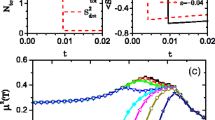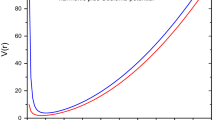Abstract
In the paper, the electronic properties of a quantum dot (QD) using the Frost–Musulin potential model are investigated taking into account both an external magnetic field and electron–electron interaction. For this purpose, the Schrödinger equation (SE) is analytically solved without considering electron–electron interaction by employing the Nikiforov–Uvarov (NU) procedure, and the energy levels and wave functions are determined. Then, the singlet–triplet (ST) transition is studied for different values of magnetic fields. According to our results, Both the dot size and magnetic field have key roles in the ground state transition. The ST transition of the ground state moves to lower magnetic fields as the QD size is increased. However the transition occurs at higher magnetic fields when the potential depth is increased. The transition for small QD size occurs only from 1S to 3P. But by increasing the QD size, another transition is also observed from 1D to 3F. These transitions occur at smaller magnetic fields when the QD size is increased.






Similar content being viewed by others
Availability of data and materials
The data that supports the findings of this study are available from the corresponding author upon reasonable request.
References
Adepoju, A.G., Eweh, E.J.: Approximate and analytical bound state solutions of the Frost–Musulin potential. Can. J. Phys. 92, 18–23 (2014a)
Adepoju, A.G., Eweh, E.J.: Approximate and analytical bound state solutions of the Frost–Musulin potential. Can. J. Phys. 92, 21–26 (2014b)
Arif, M.S., Bera, A., Ghosh, M.: Tuning diamagnetic susceptibility of impurity doped quantum dots by noise-binding energy interplay. Heliyon 5, e01147–e01152 (2019)
Ashoori, R.C., Stormer, H.L., Weiner, J.S., Pfeiffer, L.N., Baldwin, K.W., West, K.W.: N-electron ground state energies of a quantum dot in magnetic field. Phys. Rev. Lett. 71, 613–618 (1993)
Bao, C.G.: Large regions of stability in the phase diagrams of quantum dots and the associated filling factors. Phys. Rev. Lett. 79, 3475–3479 (1997)
Bimberg, D., Grundman, M., Ledentsov, N.: Quantum Dot Heterostructures. Wiley, New York (1999)
Datta, S., Ghosh, M.: Influence of impurity binding energy on the excitation dynamics of doped GaAs quantum dot: role of noise. J. Chem. Sci. 135, 15–22 (2023)
Donald, N.A.: Semiconductor Physics and Devices (Neamen), 3rd edn. McGraw-Hill, New York (2003)
Farout, M., Sever, R., Ikhdair, S.: Approximate solution to the time-dependent Kratzer plus screened Coulomb potential in the Feinberg–Horodecki equation. Chin. Phys. B 29, 060303–060309 (2020)
Frost, A.A., Musulin, B.: Semiempirical potential energy functions. I. The H2 and H2+ diatomic molecules. J. Chem. Phys. 22, 1017–1020 (1954a)
Frost, A.A., Musulin, B.: The possible existence of a reduced potential energy function for diatomic molecules. J. Am. Chem. Soc. 76, 2045–2048 (1954b)
Greene, R.L., Aldrich, C.: Variational wave functions for a screened Coulomb potential. Phys. Rev. A 14, 236–240 (1976)
Guo, K.X., Chen, C.Y.: Polaron effects on the optical second-harmonic generation in a quantum well within an electric field. Turk. J. Phys. 21, 1261–1272 (1997)
Heiss, W.D.: Quantum Dots (A Doorway to Nanoscale Physics). Springer, Berlin (2005)
Idiodi, J.O.A., Onate, C.A.: Entropy, fisher information and variance with Frost–Musulin potenial. Commun. Theor. Phys. 66, 26–275 (2016)
Inyang, E.P., Inyang, E.P., William, E.S., Ntibi, J.E., Ibanga, E.A.: Bound state solutions of the Schrödinger equation with Frost–Musulin potential using the Nikiforov–Uvarov-functional analysis (NUFA) MethodBulg. J. Phys. 49, 329–339 (2022)
Inyang, E.P., William, E.S., Obu, J.A., Ita, B.I., Inyang, E.P., Akpan, I.O.: Energy spectra and expectation values of selected diatomic molecules through the solutions of Klein–Gordon equation with Eckart–Hellmann potential model. Mol. Phys. 119, e1956615–e1956619 (2021)
Khordad, R.: Use of modified Gaussian potential to study an exciton in a spherical quantum dot. Superlatt. Microstruc. 54, 7–15 (2013b)
Khordad, R.: Optical properties of quantum wires: Rashba effect and external magnetic field. J. Lumin. 134, 201–207 (2013a)
Khordad, R.: Simultaneous effects of electron-electron interactions, Rashba spin-orbit interaction and magnetic field on susceptibility of quantum dots. J. Magn. Magn. Mater. 449, 510–514 (2018)
Khordad, R., Bahramiyan, H.: Electronic properties of a hydrogenic impurity in a quantum wire with V-shaped cross-section: spin-orbit coupling, relativistic correction and conductance. Int. J. Mod. Phys. C 24, 1350041–1350049 (2013)
Khordad, R., Mirhosseini, B.: Internal energy and entropy of a quantum pseudodot. Physica B 420, 10–14 (2013)
Khordad, R., Mirhosseini, B.: Application of Tietz potential to study singlet–triplet transition of a two-electron quantum dot. Commun. Theor. Phys. 62, 77–80 (2014)
Lennard-Jones, J.E.: Cohesion. Proc. Phys. Soc. 43, 461–482 (1931)
Maksym, P.A., Chakraborty, T.: Quantum dots in a magnetic field: role of electron-electron interactions. Phys. Rev. Lett. 65, 108–111 (1990)
Maksym, P.A., Imamura, H., Mallon, G.P., Aoki, H.: Molecular aspects of electron correlation in quantum dots. J. Phys. Condens. Matter 12, R299–R305 (2000)
Manning, M.F., Rosen, N.: A potential function for the vibrations of diatomic molecules. Phys. Rev. 44, 951–954 (1933)
Miura, N.: Physics of Semiconductors in High Magnetic Fields. Oxford University, New York (2008)
Mohamed, W.A.A., Abd El-Gawad, H., Mekkey, S., Galal, H., Handal, H., Mousa, H., Labib, A.: Quantum dots synthetization and future prospect applications. Nanothech. Rev. 10, 1926–1940 (2021)
Nazmitdinov, R.G., Simonović, N.S., Rost, J.M.: Semiclassical analysis of a two-electron quantum dot in a magnetic field: dimensional phenomena. Phys. Rev. B 65, 155307–155310 (2002)
Nikiforov, A.F., Uvarov, V.B.: Special Functiond of Mathematical Physics. Birkhauser, Basel (1988)
Okon, I.B., Popoola, O., Isonguyo, C.N.: Approximate solutions of Schrodinger equation with some diatomic molecular interactions using Nikiforov–Uvarov method. Adv. High Energy Phys. 2017, 9671816–961821 (2017)
Omugbe, E., Osafile, O.E., Okon, I.B., Inyang, E.P., William, E.S., Jahanshir, A.: Approximate solutions of the Schrödinger equation with Hulthén plus screened Kratzer potential using the Nikiforov–Uvarov-functional analysis (NUFA) method: an application to diatomic molecules. Few-Body Syst. 63, 6–9 (2022)
Onate, C.A., Onyeaju, M.C.: Dirac particles in the field of Frost–Musulin diatomic potential and the thermodynamic properties via parametric Nikiforov–Uvarov method, Sri Lankan. J. Phys. 17, 1–17 (2016)
Onyenegecha, C.P., Opara, A.I., Njoku, I.J., Udensi, S.C., Ukewuihe, U.M., Okereke, C.J., Omame, A.: Analytical solutions of D-dimensional Klein–Gordon equation with modified Mobius squared potential. Results Phys. 25, 104144–104149 (2021)
Pal, S., Ghosh, M.: Tailoring nonlinear optical rectification coefficient of impurity doped quantum dots by invoking Gaussian white noise. Opt. Quant. Electron. 48, 372–379 (2016)
Prada, M., Blick, R.H., Joynt, R.: Singlet–triplet relaxation in two-electron silicon quantum dots. Phys. Rev. B 77, 115438–115442 (2008)
Rosen, N., Morse, P.M.: On the vibrations of polyatomic molecules. Phys. Rev. 42, 210–215 (1932)
Ruan, W.Y.: Transformation bracket for 2D harmonic oscillator functions and its application to few-electron quantum dots. J. Math. Phys. 37, 3760–3768 (1996)
Tas, A., Aydogdu, O., Salti, M.: Dirac particles interacting with the improved Frost–Musulin potential within the effective mass formalism. Ann. Phys. 379, 67–82 (2017)
Varshni, Y.P., Shukla, R.C.: On the Frost–Musulin reduced potential energy function. J. Phys. Chem. 65, 2224–2226 (1961)
Wagner, M., Merkt, U., Chaplik, A.V.: Spin-singlet-spin-triplet oscillations in quantum dots. Phys. Rev. B 45, 1951–1954 (1992)
Wei, H.: Four-parameter exactly solvable potential for diatomic molecules. Phys. Rev. A 42, 2524–2530 (1990)
William, E.S., Onye, S.C., Ikot, A.N., Nwachukwu, A.N., Inyang, E.P., Okon, I.B., Akpan, I.O., Ita, B.I.: Magnetic susceptibility and magnetocaloric effect of Frost–Musulin potential subjected to magnetic and Aharonov–Bohm (Flux) fields for CO and NO diatomic molecules. J. Theor. Appl. Phys. 17, 172318–172329 (2023)
Woods, R.D., Saxon, D.S.: Diffuse surface optical model for nucleon-nuclei scattering. Phys. Rev. 95, 577–581 (1954)
Xie, W.F.: Four-electron quantum dots in magnetic fields. Solid State Electron. 43, 2115–2122 (1999)
Xie, W.F.: Ground state of a two-electron quantum dot with a Gaussian confining potential. Chin. Phys. Lett. 23, 193–195 (2006a)
Xie, W.F.: Singlet–triplet transitions of a Pöschl–Teller quantum dot. Commun. Theor. Phys. 46, 1101–1105 (2006b)
Xie, W.F.: Four-electron systems confined in multilayer quantum dots. Mod. Phys. Lett. B 21, 1399–1413 (2007)
Xie, W.F.: A study of ground state behavior of a two-electron quantum ring. Mod. Phys. Lett. B 23, 2361–2367 (2009a)
Xie, W.F.: A study of two confined electrons using the Woods–Saxon potential. J. Phys. Condens. Matter 21, 115802–115808 (2009b)
Xie, R.H., Gong, J.: Simple three-parameter model potential for diatomic systems: from weakly and strongly bound molecules to metastable molecular ions. Phys. Rev. Lett. 95, 263202–263208 (2005)
Xie, W.F., Wang, A.: Ground state transitions in vertically coupled N-layer single electron quantum dots. Solid State Commun. 128, 369–373 (2003)
Yin, Y.: Singlet–triplet relaxation induced by confined phonons in nanowire-based quantum dots. Semicond. Sci. Technol. 25, 125004–125009 (2010)
Funding
Not applicable.
Author information
Authors and Affiliations
Contributions
RK wrote the manuscript. He prepared all the figures. He discussed the results and contributed to the final manuscript.
Corresponding author
Ethics declarations
Conflict interest
The authors declare that there is no conflict of interest regarding the publication of this paper.
Ethical approval
Not applicable.
Additional information
Publisher's Note
Springer Nature remains neutral with regard to jurisdictional claims in published maps and institutional affiliations.
Appendix 1
Appendix 1
In this part, we present a detail of the solution of the Schrödinger equation (SE) for one particle with FM potential exposed to magnetic field. In 2D, the SE can be written as
where \({E}_{nl}\), and \({m}_{e}\) are the system’s energy and the effective mass. The vector potential in the cylindrical coordinates is chosen as
The wave function in the cylindrical coordinates is written as
Inserting Eqs. (8) and (10) in Eq. (8), we obtain
where \({\omega }_{c}=eB/{m}_{e}\). To solve Eq. (11), we use the Greene-Aldrich approximation (Greene and Aldrich 1976). The approximation is written as
Now, we introduce a new parameter as \(t={e}^{-\alpha x}\). Then, Eq. (11) can be written as
where
In Eq. (14), the used parameters are as
Now, we use the Nikiforov–Uvarov (NU) procedure to obtain the energy levels and wave functions. A brief illustration of the NU method is explained here that has been proposed by Nikiforov and Uvarov (Nikiforov and Uvarov 1988). Using the following coordinate transformation, \(t=t(x)\), this equation is given by
Here \(\overline{\omega }(t)\), \(\vartheta (t)\), and \(\widetilde{\vartheta }\left(t\right)\) are polynomials. Then, the parametric NU equation is written as (Okon et al. 2017)
The used constants in Eq. (17) are as below
The energy equation is given by
Applying the NU method, we can obtain the energy levels as
where
The wave functions can be written as
where \({P}_{n}^{(\alpha ,\beta )}\left(x\right)\) are the Jacobi polynomials and
Rights and permissions
Springer Nature or its licensor (e.g. a society or other partner) holds exclusive rights to this article under a publishing agreement with the author(s) or other rightsholder(s); author self-archiving of the accepted manuscript version of this article is solely governed by the terms of such publishing agreement and applicable law.
About this article
Cite this article
Khordad, R. The singlet–triplet transition of two interacting electrons in a Frost–Musulin quantum dot. Opt Quant Electron 56, 596 (2024). https://doi.org/10.1007/s11082-023-06199-1
Received:
Accepted:
Published:
DOI: https://doi.org/10.1007/s11082-023-06199-1




